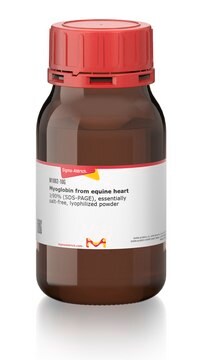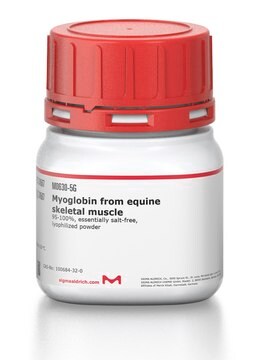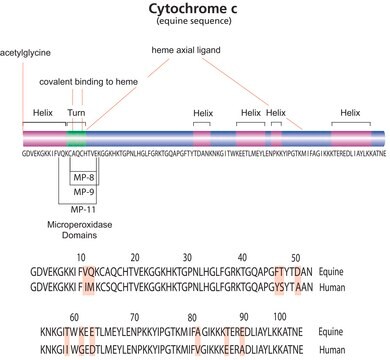Key Documents
C2037
Cytochrome c from bovine heart
≥95% based on Mol. Wt. 12,327 basis
About This Item
Polecane produkty
pochodzenie biologiczne
bovine heart
Poziom jakości
Próba
≥95% based on Mol. Wt. 12,327 basis
Postać
powder or crystals
masa cząsteczkowa
12327 Da
metody
cell based assay: suitable
przydatność
suitable for molecular biology
numer dostępu UniProt
Zastosowanie
cell analysis
temp. przechowywania
−20°C
informacje o genach
cow ... CYC1(512500)
Szukasz podobnych produktów? Odwiedź Przewodnik dotyczący porównywania produktów
Opis ogólny
Zastosowanie
- for cytochrome oxidase staining using the mice brain tissue
- as a component of control mixture to evaluate the accuracy of tandem mass spectra in identifying peptides
- to study its effect on the stability, transport, and retention of biochar colloids (BCs) in saturated porous media under various solution pH and ionic strength (IS) conditions
- as a component of staining solution for the detection of cytochrome oxidase activity in the brain tissue sections of mouse
- as a component in the assay to study its superoxide scavenging efficiency
- as a component of serum-free DMEM media to evaluate non-specific cytochrome C reduction in astrocytes and HT-29 cells
Działania biochem./fizjol.
Cytochrome c has been identified as an important mediator in apoptotic pathways. The release of mitochondrial cytochrome c into the cytoplasm stimulates apoptosis and is commonly used as an indicator of the apoptotic process in the cell. Investigation on the effect of Paris Saponin I (PS I) on human gastric carcinoma cell growth (SGC7901 cells) have shown an elevated level cytoplasmic cytochrome c. Results are an inhibition of proliferation in SGC7901 cells by inducing mitochondria-dependent apoptosis through cytochrome.
Uwaga dotycząca przygotowania
Inne uwagi
Zastosowanie
Kod klasy składowania
11 - Combustible Solids
Klasa zagrożenia wodnego (WGK)
WGK 3
Temperatura zapłonu (°F)
Not applicable
Temperatura zapłonu (°C)
Not applicable
Środki ochrony indywidualnej
Eyeshields, Gloves, type N95 (US)
Certyfikaty analizy (CoA)
Poszukaj Certyfikaty analizy (CoA), wpisując numer partii/serii produktów. Numery serii i partii można znaleźć na etykiecie produktu po słowach „seria” lub „partia”.
Masz już ten produkt?
Dokumenty związane z niedawno zakupionymi produktami zostały zamieszczone w Bibliotece dokumentów.
Klienci oglądali również te produkty
Produkty
Learn about the four membrane-bound protein complexes that make up the electron transport chain metabolic pathway supplying energy as ATP for cellular respiration.
Separation of Ribonuclease A from bovine pancreas, Type I-A, powder, ≥60% RNase A basis (SDS-PAGE), ≥50 Kunitz units/mg protein; α-Chymotrypsinogen A from bovine pancreas, essentially salt-free, lyophilized powder; Cytochrome c from bovine heart, ≥95% based on Mol. Wt. 12,327 basis; Lysozyme from chicken egg white, lyophilized powder, protein ≥90 %, ≥40,000 units/mg protein
Separation of Ribonuclease A from bovine pancreas, Type I-A, powder, ≥60% RNase A basis (SDS-PAGE), ≥50 Kunitz units/mg protein; α-Chymotrypsinogen A from bovine pancreas, essentially salt-free, lyophilized powder; Cytochrome c from bovine heart, ≥95% based on Mol. Wt. 12,327 basis; Lysozyme from chicken egg white, lyophilized powder, protein ≥90 %, ≥40,000 units/mg protein
Chromatograms
application for HPLCapplication for HPLCapplication for HPLCNasz zespół naukowców ma doświadczenie we wszystkich obszarach badań, w tym w naukach przyrodniczych, materiałoznawstwie, syntezie chemicznej, chromatografii, analityce i wielu innych dziedzinach.
Skontaktuj się z zespołem ds. pomocy technicznej







